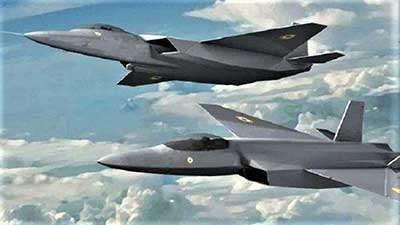Relevance: GS-3: Achievements of Indians in science & technology; indigenization of technology and developing new technology.
Key phrases: AMCA, fifth generation fighter aircraft, ADA, DRDO, HAL, Stealth aircraft, manoeuvrability.
Why in News?
- India and France are close to concluding a deal, likely in the next couple of months, for the joint development of a 125KN engine for the indigenous fifth generation Advanced Medium Combat Aircraft (AMCA) under development, according to defence officials.
What is Advanced Medium Combat Aircraft?
- The Advanced Medium Combat Aircraft (AMCA) is an Indian programme to develop fifth generation fighter aircraft for the Indian Air Force and the Indian Navy which will also include sixth generation niche technologies.
- The design of the aircraft is carried out by Aeronautical Development Agency (ADA), an aircraft design and development agency constituted under Defence Research and Development Organisation (DRDO).
- It is expected to be produced by a public-private joint venture between the DRDO, Hindustan Aeronautics Limited (HAL), and French engine maker Safran.
- The programme has an aim to start production by 2028. The development cost is estimated to be around ₹15,000 crore.
- AMCA will be a single-seat, twin-engine, stealth all-weather swing-role fighter aircraft. Two variants of AMCA will be produced in a phased production model. AMCA Mark 1 will come equipped with fifth generation technologies and Mark 2 will have the incremental sixth generation technology upgrades.
- The initial design of the AMCA started way back in 2009 and is envisaged as a twin engine stealth aircraft with internal weapons bay and Diverterless Supersonic Intake, which has been developed for the first time and for which the design is complete, as reported by The Hindu earlier. It will be a 25 tonne aircraft with internal carriage of 1,500 kg of payload and 5,500 kg external payload with 6,500 kg of internal fuel.
- The configuration has been frozen, Preliminary Service Quality Requirements (PSQR) are finalised and the preliminary design review is complete. The Critical Design Review (CDR) is expected later this year with the roll out planned in 2024 and first flight planned in 2025.
- The AMCA will have stealth and non-stealth configurations, and would be developed in two phases — an AMCA MK1 with existing GE414 engine, and an AMCA Mk2 with an advanced, more powerful engine planned to be jointly developed.
- Simultaneously, the project for the development of a twin engine deck-based fighter jet meant to fly from the Navy’s aircraft carriers is also making progress. On the various programmes underway, Dr. Deodhare said there is commonality of systems and technologies.
- The AMCA which is intended to perform a multitude of missions including air superiority, ground-strike, Suppression of Enemy Air Defenses (SEAD) and electronic warfare (EW) missions would be a potent replacement for the Sukhoi Su-30MKI air superiority fighter, which forms the backbone of the IAF fighter fleet.
- The AMCA design is optimised for low radar cross section and supercruise capability.
What is the Stealth technology aircraft?
- Stealth aircraft are designed to avoid detection using a variety of technologies that reduce reflection/emission of radar, infrared, visible light, radio frequency (RF) spectrum, and audio, collectively known as stealth technology.
- While no aircraft is totally invisible to radar, stealth aircraft make it more difficult for conventional radar to detect or track the aircraft effectively, increasing the odds of an aircraft successfully avoiding detection by enemy radar and/or avoiding being successfully targeted by radar guided weapons.
- Stealth is the combination of passive low observable (LO) features and active emitters such as low-probability-of-intercept radars, radios and laser designators.
- These are usually combined with active measures such as carefully planning all mission maneuvers in order to minimize the aircraft's radar cross-section, since common actions such as hard turns or opening bomb bay doors can more than double an otherwise stealthy aircraft's radar return.
Advantages of Stealth Technology
- Efficiency can be increased while in a war zone when stealth vehicles are used in place of conventional vehicles, providing long term fiscal savings.
- Strikes from a stealth fighter aircraft prevent enemies from initiating attacks and as enemies are unable to locate them stealth weapons are utilized as intimidation fleets.
- Decline in casualty rates is achievable using stealth technology in warfare.
Disadvantages of Stealth Technology
- Compared to conventional aircrafts, stealth aircrafts are less agile and lack efficient maneuverability.
- Stealth aircraft have lower payload or carrying capacity than the conventional aircraft.
- The biggest disadvantage of a stealth aircraft is its high cost. Ex. Fighter aircraft such as B-2 ($2 billion) and F-22 ($100 million) are the most expensive aircraft in the world.
Way forward:
- Therefore, India has decided to manufacture the fifth generation Advanced Medium Combat Aircraft on its own, while reducing the dependence on foreign country export and promoting 'Self-reliant India' and 'Make in India' mission.
- Once the agreement is concluded with France, development of the aircraft as well as the engine should progress parallelly to meet the timelines.
- The manufacturing and production of the aircraft should planned through a Special Purpose Vehicle, which will also involve private industry.
- AMCA would ensure India’s entry into the elite club of countries with fifth-generation stealth warplanes. So far, only the US (F-35 and F-22 Raptor), Russia (Su-57 Felon), and China (J-20) have fifth-generation aircraft in their arsenal. Many experts believe that India could become the fourth country to operate an indigenous stealth fighter aircraft.
Source: The Hindu
Mains Question:
Q. Discuss how the 'Self-reliant India' and 'Make in India' missions can make India’s defence capabilities stronger. Critically Analyse.







